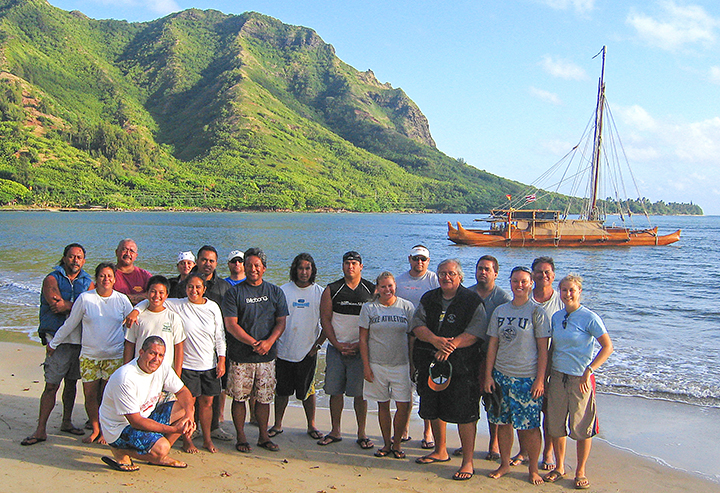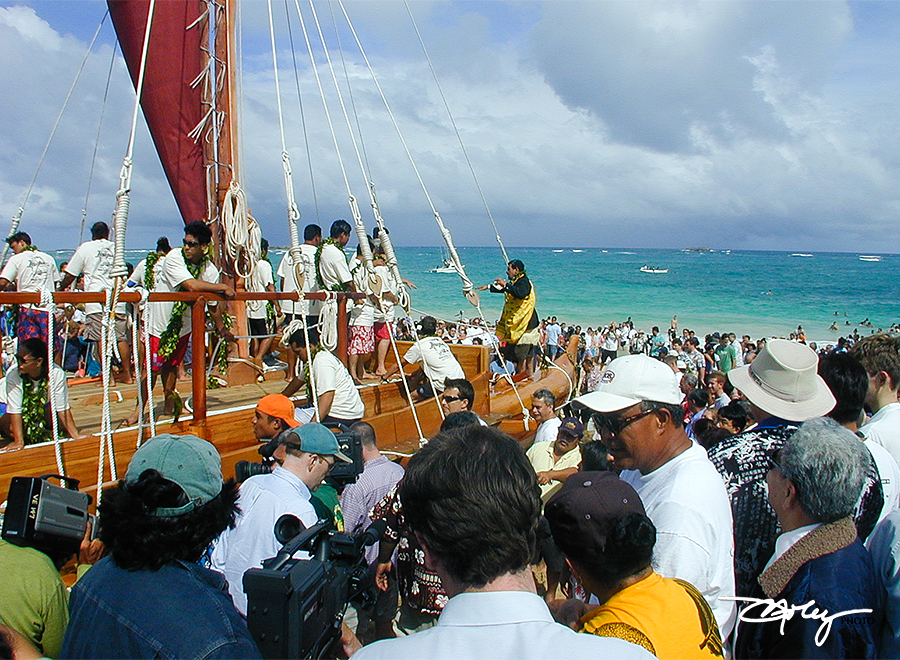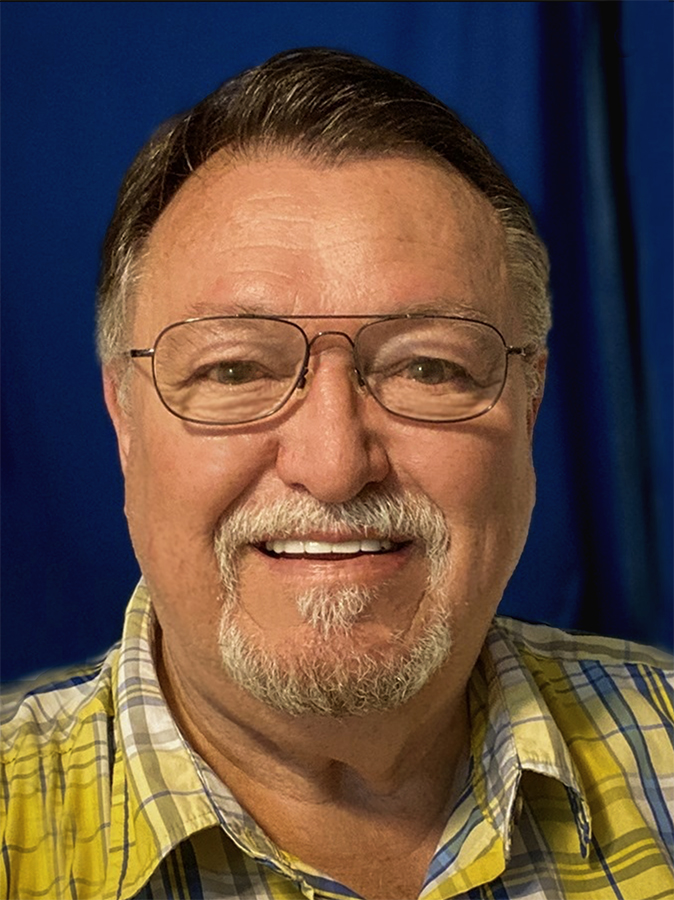
Story by Mike Foley
Iosepa, BYU–Hawaii’s 57-foot twin-hulled traditional sailing canoe — called a wa’a kaulua in Hawaiian — has been berthed in the Hālau Kauaiwi’ulaokalani canoe learning center at the Hawaiian Village since 2008, where several million people have seen it up close.
In an October 23, 2023, interview with Keali’i Haverly, Center Vice President of Sustainability, Cultural Theming, Maintenance, Planning and Projects, he explained the PCC, in agreement with BYU–Hawaii and with approval from their respective boards of directors and trustees, recently increased its kuleana or responsibility “in taking a more active role in the repair and maintenance” of the impressive vessel.
“We realized the Center needed to be more realigned with the concept that our people transported themselves and their goods by way of the ocean, and the ocean was a ‘highway’ — not a divider but a unifier.”
The 2024 Festival of Pacific Arts and Culture …will be held in Honolulu, Hawaii, for the first time, from June 6–16, 2024, with the theme Ho’oulu Lāhui: Regenerating Oceania; and it will include a gathering of as many of the Polynesian voyaging canoes as can come. Haverly said this also made such a decision easier.
According to the Festival’s Hawaii website, a Wa’a Arrival Ceremony will tentatively be held at Kualoa Regional Park — which has “deep cultural and historical significance for traditional Polynesian navigation — on June 5, 2024 (starting at 6 a.m.).
“Our board of directors was completely positive and unanimous in their support in terms of assisting in the preservation of this priceless gem in our community,” said Haverly.
Drydocking the canoe: Haverly also noted hands-on refurbishing “began in April 2023, starting with following the direction given to us by many in the voyaging community, including past leaders of Iosepa’s fabrication, repair, maintenance, and sailing — Kamoa’e Walk and Uncle Kawika. The consensus was clearly to get the hulls down to their original wood surface, so we can repair any damage and reapply the several coats of epoxy and varnish to it. All other delaminated or bare areas of the canoe also need to be prepped and re-glassed.”
“Our carvers team — under the direction of Tommy Tsing and including master carver Jared Pere along with Shane Rupp, and JC Lambert — are engaged in that now,” Haverly said. He added that Pulotu, who is now 82 years old, has visited and consulted but is no longer expected to drag out his well-known chain saws, and Kawika Eskaran also recently retired from the Center.
“We have other staff members and senior missionaries who are pretty much involved daily, and we’re probably about 60 percent completed with that effort.”
Volunteers still welcome: Haverly also noted that BYU–Hawaii students and community members have also been volunteering to help with the drydock process.
Since post-COVID when the Center is usually closed on Wednesdays, the carvers and volunteers have been meeting at the outside gate to the canoe hālau on those afternoons from 4–6 p.m. to help.
“We have had over 100 people come out on these Wednesdays,” Haverly said, “with the smallest group of about 25 people. They’ve typically been doing unskilled sanding of epoxy, and sanding wood, and it has been an awesome experience.”
Training a canoe crew: Haverly stressed that Nā Kalai Wa’a ‘ohana in Kawaihae also still remains strongly tied to the Iosepa. “We’ve been to their trainings, and they’ve given us trainings. In fact, they were here during our sixtieth anniversary week, and we had an amazing training session with them then.”
“They’ve been very positive toward Iosepa,” Haverly said, “and they adhere to spreading the voyaging legacy throughout all the islands. We’re fortunate to be ‘ohana with them.”
The training canoe, Ka ‘Uhane Holokai: Furthermore, he said, “We currently provide limited crew training using our 24-foot training canoe, Ka ‘Uhane Holokai, which can even be put on the lagoon. “But the primary focus we have right now is to complete Iosepa’s readiness, plus we plan to keep Ka ‘Uhane on the water when guests are here.”Regarding the latter, Haverly explained the Center has been working closely with Mark Holladay Lee, a well-known photographer from Hauula who’s done a lot of commercial work for Center’s advertising and public relations agencies, “but he’s also a skilled waterman who’s surrounded himself with canoe builders. Under our direction, he repurposed one of our 24-foot fiberglass pageant canoes, converting it into a mini-version of the Iosepa. We call it Ka ‘Uhane Holokai” (“the Soul of the Seafarer”).
Transporting the Iosepa and Ka ‘Uhane Holokai to the water: Large trucks and trailers can easily access the Hālau Kauaiwi’ulaokalani where Iosepa and the smaller Ka ‘Uhane Holokai stay, through a gate at the corner of Naniloa Loop and Iosepa Street to transport either to the water. The big-rig lowboy trailer Hauula home-mover Babe Keanu used to haul the 57-foot-long Iosepa, which is estimated to weigh about 10 tons “dry” (i.e., unloaded) during its earliest moves to Hukilau Beach, is “beyond its useful life,” and Keanu has passed away.
Taking all that into consideration, Haverly said service missionary welders or others will probably have a new trailer ready for Iosepa by the first quarter of 2024. In the past, BYU–Hawaii obtained special permission from the State to launch and land Iosepa at Hukilau Beach. “That is tentatively still our hope, pending new approvals,” Haverly said.
Meanwhile, Ka ‘Uhane, which is not nearly as heavy or as challenging to transport, can much more easily be hauled to the closest state boat ramp at Kahana Bay to launch. Ka ‘Uhane has also already launched safely and easily from the official boat ramp at He’eia and sailed in nearby Kaneohe Bay.
“Canoe culture” at the Center: Where is all of this going? Haverly explains the answer is much larger than repairing the Iosepa. For instance, the Center has used canoes to transport guests on the lagoon or as a floating “stage” to dance on since the very beginning in 1963.
However, instilling a “canoe culture” in the staff and visitors is directly related to the Center’s motto:
One ‘Ohana Sharing Aloha, and vision to Spread Aloha Around the World.”
A brief history of the Iosepa
Mid-1970s: A renaissance in creating traditional Polynesian sailing canoes and wayfinding navigation began in Hawaii. The Polynesian Voyaging Society’s Hōkūle’a is the best-known early example.
(Interestingly, they called upon the Polynesian Cultural Center for help to finish thatching the fale on the deck.) The renaissance subsequently spread throughout the South Pacific.
February 12, 1998: President Eric B. Shumway announced BYU–Hawaii’s Hawaiian Studies program would begin in the Fall Semester that year, with William Kauaiwi’ulaokalani “Uncle Bill” Wallace III, a former PCC senior manager, as its first director. Wallace and his “team” dream they might add a sailing canoe to their program.
Eventually given permission, in 2000 BYU–Hawaii commissioned Tui’one Pulotu, a former labor missionary from Tonga who remained in Laie and is well-known for his carving skills, as head master carver, and also Hawaiian carver Kawika Eskaran to create a wooden canoe. With no suitably sized logs available in Hawaii, Pulotu ordered the wood from Fiji.
February 7, 2001: The logs arrived at a vacant site (managed by Hawaii Reserves, Inc.) adjacent to the Hawaiian Village (approximately where McDonald’s Laie now stands). Pulotu and others immediately began to shape the canoe, which took about nine months to complete.
October 2001: Uncle Bill announced he would name the canoe Iosepa, following directions he received in a dream of his Hawaiian grandfather who had migrated to the Iosepa Colony in Skull Valley, Utah, in the 1880s.
November 3, 2001: Thousands gathered at Hukilau Beach in Laie to participate in the dedication and launching ceremonies for the Iosepa, including a community luau. Elder M. Russell Ballard, a senior member of the Quorum of the Twelve Apostles of The Church of Jesus Christ of Latter-day Saints, dedicated the canoe. The Church called his great-grandfather, Joseph F. Smith, as a missionary to the Sandwich Islands (i.e., Hawaii) in 1854 when he was 15 years old, and the young missionary was soon given the Hawaiianized name, Iosepa. (Smith later became president of the Church and dedicated the site for the Laie Hawaii Temple.)
About this same time, BYUH President Eric B. Shumway began seeking donations from the Presidents’ Leadership Council, Latter-day Saint philanthropists who work closely with the two institutions, to build a new hālau wa’a (canoe learning center) in the PCC’s Hawaiian village, where the Iosepa could be permanently berthed and on display when not sailing.
May 19, 2004: A tractor-truck with a low-boy trailer hauled Iosepa from the BYU–Hawaii campus to Hukilau Beach. A few days later it embarked on its first significant voyage beyond near-shore Oahu to Kawaihae on Hawaii Island, home of its “training” ‘ohana (or family), Nā Kalai Wa’a and their sailing canoe, Makali’i, to undergo extensive training and sea trials.
June 24, 2004: In addition to training, BYU–Hawaii President Shumway, members of his executive council, PCC president Von Orgill, LDS Foundation staff and several major donors joined the crew aboard Iosepa for a morning sail in the gentle breezes off the Kōhala coast. The Makali’i ‘ohana put on a luau when they returned, and in turn, the BYUH/PCC contingency presented them with a new mast for their canoe.
July 23, 2004: Community kūpuna (elders), residents, and BYU–Hawaii officials welcomed the crew of Iosepa back on Hukilau Beach in Laie.
November 6, 2007: PCC, BYU–Hawaii, and CES leaders break ground for the new hālau wa’a in the Hawaiian Village.
June 25, 2008: Mark Willes, chairman of the Center’s board of directors, dedicated the new Hālau Wa’a O Iosepa. The name was later changed to Hālau Kauaiwi’ulaokalani to honor the recent passing of “Uncle” Bill Wallace III, who played a key role in bringing the Iosepa to “life.”
Since then, Iosepa undertook several training sails in near-shore Oahu waters and remains berthed in the Hawaiian Village during its current drydock period.
Late 2022: The Center commissioned Mark Holladay Lee to convert one of its pageant performance canoes into a smaller-sized training canoe, Ka ‘Uhane Holokai (“the Soul of the Seafarer”).
April 2023: The Center became more closely aligned with supporting the BYU–Hawaii sailing canoe, Iosepa.


Mike Foley, who also goes by his Sāmoan and Hawaiian name Mikaele, first visited the Polynesian Cultural Center on his way home from serving for 2.5 years in the Samoa Mission. A few months later, he returned to Laie to enroll at the Church College of Hawaii, and also got a student-job at the Center. He has worked intermittently at the Center ever since, 60-ish years, including about 25 years full-time in marketing communications, PR and advertising. During the earliest of those years, he met and married Sally Ann McShane, a beautiful young Hawaiian dancer (who came to Laie in 1963). They raised their family in Laie and still live there.
View all posts